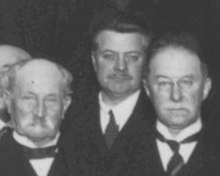Roland Weitzenböck

Roland Weitzenböck (born May 26, 1885 in Kremsmünster , † July 24, 1955 in Zelhem , Netherlands ) was an Austro-Dutch mathematician.
Life
Weitzenböck studied at the Technical Military Academy Mödling (today HTL Mödling ) from 1902 to 1904 and became a captain in the Austrian army. He then studied at the University of Vienna, where he received his doctorate in 1910 ("On the system of 3 ray complexes in 4-dimensional space"), then studied in Bonn and Göttingen , where he completed his habilitation ("About some special collineations of the "). In 1912 he became a private lecturer in Graz and (after serving in the army in World War I ) in 1918 professor of mathematics at the Karl Ferdinand University in Prague . In 1923 he became a mathematics professor in Amsterdam , which he remained until 1945.
While he was not politically active before World War II (though he harbored strong revanchist, anti-French feelings), he openly showed his pro-German attitude during the German occupation in World War II. After the Dutch surrender in May 1940, he joined the National Socialist movement in the Netherlands NSB, but resigned in September 1941 and he was never a member of the NSDAP . He took German citizenship in 1942 and became a reserve officer (as a former ku k officer). In 1942 he was assigned to the protection group and in 1944 had to replace the commander of the district office in Hilversum, where he was responsible for billeting the military. His sympathies were mainly based on the fact that he approved of the war against France, they did not go so far that he denounced Jews or members of the resistance and he used his influence to win over the Marxist mathematician and philosopher Gerrit Mannoury (1867– 1956) to protect. His activities as a quartermaster and his pro-German attitude had made him unpopular. In 1946 he was arrested and interned. His behavior during the occupation was examined very carefully without any particular incriminating facts coming to light. He was not released until 1948; part of his property was confiscated, he lost his offices and his pension rights, had to give up his German citizenship and his passport was confiscated. He moved to Zelhem on the German border to be closer to his daughter, who was a nurse.
His wife and one of his sons died in a bomb attack in 1940, and his second son was killed on the Eastern Front.
Weitzenböck dealt with invariant theory, especially differential invariants. In 1928/9 he corresponded with Albert Einstein and also worked on his remote parallel theory of a unified field theory.
He had been a corresponding member of the Prussian Academy of Sciences since 1940 .
His doctoral students include Daniel Edwin Rutherford , George François Cornelis Griss (1898–1953), the founder of a variant of intuitionism without negation, and the world chess champion Max Euwe . The leading Amsterdam mathematician LEJ Brouwer , who brought Weitzenböck to Amsterdam, was reluctant to take on doctoral students and usually referred them to Weitzenböck or Hendrik de Vries .
Weitzenböck was a strong chess player and at times president of the chess club in his place of residence, Blaricum .
See also
Fonts
- Complex symbolism. An introduction to the analytical geometry of multidimensional spaces , Göschen 1908.
- Invariant theory , Groningen, Noordhoff, 1923.
- The four-dimensional space , Vieweg 1929, Basel 1956.
- Recent work on algebraic invariant theory. Differential invariants . Encyclopedia of Mathematical Sciences, III, Vol. 3, Teubner 1921.
- Differential invariants in Einstein's theory of remote parallelism , reports from the Prussian Academy of Sciences, Phys.-Math. Class, 1928, p. 466.
Web links
- Literature by and about Roland Weitzenböck in the catalog of the German National Library
- Roland Weitzenböck in the Mathematics Genealogy Project (English)
Individual evidence
- ↑ The first letters of the introduction to his book Invariant Theory resulted in the sentence Down with the French . Dirk van Dalen Mystic, Geometer and Intuitionist , Clarendon Press, Volume 2, 2005, p. 717.
- ↑ Dirk van Dalen loc. cit., p. 717.
- ↑ He knew, for example, of Jews in hiding in the Mathematical Institute and of resistance activities at the Institute (the resistance stored ammunition there). Van Dalen, loc. cit. P. 776.
- ↑ Dirk van Dalen, loc. cit. P. 775. On page 776 there is a picture of Weitzenböck in uniform.
- ↑ Van Dalen, loc. cit. P. 791.
- ↑ See Tilman Sauer "Field equations in Teleparallel Spacetime: Einstein's Fernparallelismus approach towards unified field theory", 2004, PDF.
- ↑ Dirk van Dalen loc. cit., p. 519.
| personal data | |
|---|---|
| SURNAME | Weitzenböck, Roland |
| BRIEF DESCRIPTION | Austro-Dutch mathematician |
| DATE OF BIRTH | May 26, 1885 |
| PLACE OF BIRTH | Kremsmünster |
| DATE OF DEATH | July 24, 1955 |
| Place of death | Zelhem , Netherlands |
